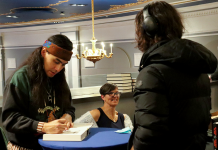
Movie review about Hidden Figures from two separate Chronicle writers; Euvilla Thomas and Tommy Morais.
Hidden Figures: An iconic box office success for women everywhere

Black women everywhere have something to celebrate with the movie Hidden Figures, (2016) not Hidden Fences: the faux pas Jenna Bush made on the red carpet during the 2017 Golden Globes, bless her heart. Hidden Figures is an inspiring and educational film not just for black women, but women everywhere.
The movie, which was directed by Theodore Melfi, gave viewers exactly what they expected based on the trailers. According to an article by the Huffington Post, the movie is the first live-action film with three female leads to hit No. 1 in the box office since 2011. The film has earned about 60 million dollars since its release on Jan. 6. Set in 1962, when segregation in America was in full force, the film reveals how being black was almost equivalent to being a criminal.
Imagine not being able to share a washroom, a coffee machine, a library or even being denied going to a certain school or getting a job because you were black.
Hidden Figures takes us through the community of black women and the challenges they faced as mathematicians in NASA. This movie captured the role African-American women played in the historic launch of America’s first orbit into space. The movie was inspired by true events and based off the book written by Margot Lee Shetterly. The movie stars Octavia Spencer, Taraji P. Henson and Janelle Monae. Hidden Figures takes us on a fight of survival, equality and bravery, all through the lives of three coloured women.
“Well, it isn’t illegal to be Negro,” says a head strong Monae who plays Mary Jackson, the first coloured woman to be an engineer at NASA. This opening scene gives us a glimpse into what it means to be black in America during segregation.
The main character Katherine Johnson is a mathematician who made the calculations which allowed humans to travel into space. In those days’, people with these capabilities were called “Human Computers.”
Despite having been instrumental in launching the first American man into space, Katherine Johnson still had to deal with the every day challenges which came with being black. The most compelling scene in the movie is when Mr. Harris played by Kevin Costner, takes down the sign on the bathroom door and says, “Here at NASA, we all pee the same colour.”
This is a movie, which shows with hard work and dedication, anything is possible. You can be the first of whatever your dreams are.
Watch Hidden Figures and be inspired by women of colour making a real difference and putting their mark on history forever.

Hidden Figures; New Role Models in the black community

Look out Beyonce and Alicia Keys. Black women have new role models to look up to. Directed by Theodore Melfi, Hidden Figures takes its cue from American history and brings the stories of three black women in their pursuit of equal rights to the big screen.
The biographical drama details the lives of Kathrine Johnson, Dorothy Vaughan and Mary Jackson: three African-American women who broke racial barriers and sexist boundaries while working at NASA in the early ‘60s. Hidden Figures focuses on Johnson, a brilliant mathematician who helped put the first American man into space with her affinity for numbers. It sounds like a perfectly crafted Hollywood scenario, only the events depicted actually happened. Appropriately, the movie was released just ahead of Martin Luther King Jr. Day.
Hidden Figures not only rebuts the old adage that women are bad at math, but shatters it. Katherine Johnson isn’t just smart, she’s so smart you couldn’t possibly calculate it. But she could, of course.
Actress Taraji P. Henson delivers a subtle and quiet performance as Johnson. Henson embodies the spirit of the smart mathematician and mother of three. Janelle Monae provides the comic relief as Mary Jackson with her wit and flirty demeanour with the male characters in the movie. It is perhaps Dorothy Vaughan, played by Octavia Spencer, who best exemplifies the struggles of black women in the workplace when she is denied promotion after promotion.
Despite the challenges faced by our three protagonists, Hidden Figures is a lighter version of history. The characters around them all appear too polite for 1960’s America. The superiors Paul Stafford (Jim Parsons) and Vivian Michael (Kirsten Dunst) are very careful in their behaviour in an unforgiving era. All three women are challenged by racism and sexism in not only the workplace, but in every day life. Coloured washrooms, dirty looks and being overlooked for promotions because of race are just a few of the obstacles the three women face.
Hidden Figures is captivating and informative, a far cry from the hangover of 2016 where movies like Ghostbusters and Bad Moms were criticized by critics and audiences alike and for making women look goofy.
The film has already won 6 of its 9 nominations from the Women Critic Film Circle, including best movie about women in 2016. It also received further nominations including 2 Golden Globes and 3 Oscars.
In 2017 race and gender issues still exist, but Johnson, Vaughan and Jackson’s stories prove it possible for not only black women, but for all women to succeed if they work hard, and want it bad enough. Perhaps one day there will be a Katherine Johnson day.





